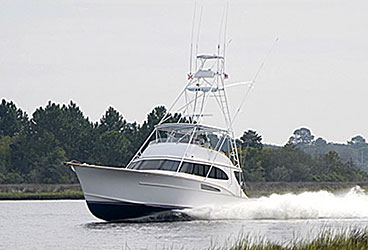
Rybovich 60
Tommy, John and Emil Rybovich built their first sportfisherman in Palm Beach, Florida, in 1947. Miss Chevy’s design answered the needs of a growing number of wealthy sportsmen pioneering the bluefin tuna and marlin fishery in the nearby Bahamas. During the next 40 years, the yard produced 84 boats and earned a reputation for top quality, performance and innovation. Since 1986, master builder Gary Hilliard has carried the torch along with a strong respect for tradition. While the interior design and layout of a Rybovich is “negotiable,” Hilliard pens each profile and keeps changes to exterior styling off-limits.
This new Rybovich 60, On Guard, shows the good sense of his approach. She not only looks right, with her trademark bridge rail, clean foredeck and moderately raked house, she looks like a Rybovich. What makes her different is her interior, which the owner essentially gave Hilliard a free hand in developing. He had one challenging request: to include windows in the house face. This is an uncommon feature on modern sportfishermen because owners usually opt for the additional stowage an unglazed house face allows. At 60 feet, On Guard is not pressed for stowage, and the natural lighting makes her saloon seem larger. This effect is complemented by an open saloon/galley arrangement with a wide granite galley counter and under-counter refrigeration. To reduce unnecessary weight, the granite counter is cored with honeycomb. Aft, a large U-shape leather sofa and coffee table are positioned strategically in front of a 42-inch plasma screen, part of a state-of-the-art audio-visual system hidden neatly in the cabinetry.
Accommodations include a master stateroom with an island berth and a private head forward. A guest stateroom to starboard has upper and lower berths. A guest stateroom to port has the same, as well as private entry to a head that can be accessed from the passageway as a day head. On Guard’s interior, while not unique in arrangement, displays a noteworthy level of craftsmanship. Hilliard handpicks every stick of wood that finds its way into a Rybovich. On Guard’s finely fitted, satin-finished teak joinery is the yard standard. Each of the raised panel doors (her only interior option) was cored with honeycomb and took roughly 40 hours to complete.
On Guard’s cockpit is finished with equal attention. The teak sole and covering boards are perfect. A fighting chair, live well and refrigerated fishbox are all standard fare on a Rybovich, as are the glasslike bulkhead and bait prep center, which receive 10 coats of varnish. A refrigerated drink box, a freezer, a sink and a bank of tackle drawers are hidden within. A full tower, designed and built by Rybovich, is also fitted. On Guard’s owner likes to bottom fish and insisted on an anchor pulpit and windlass. These are not standard on tournament boats, and Rybovich cleverly integrated the system into the design. The push of a button on the bridge deploys the anchor. When retrieved, it tucks almost out of sight beneath the pulpit.
When Hilliard took the helm at Rybovich, the yard was still using the hull form Tommy Rybovich developed in the 1970s. The company’s sea boats were excellent, but demand for larger, faster, long-range designs necessitated a new approach. Naval architect Donald Blount was called in for a bit of fine-tuning. The result is finer forward sections and cleaner after sections with a bit more deadrise and chine beam. A down-angle chine rail was added to control spray. Underwater hardware was redesigned in stainless steel. Flush-mounted strut palms and wedge style rudders were used to help reduce appendage drag. All the subtle refinements, first employed on a 58-footer, were extended to produce On Guard’s 60-foot hull. The same thinking filtered into the yard’s 55-foot, 65-foot and 72-foot designs.
On Guard’s hull was cold-molded over a disposable jig. Her keel and stringers are laminated mahogany, her engine beds are laminated Douglas fir and her bulkheads are marine plywood. After these members were set in place on the jig, she was sheathed with three layers of diagonal 5/16-inch mahogany, which was both epoxy glued and mechanically fastened. Her exterior surfaces and engineroom interior are covered with several layers of fiberglass cloth and epoxy resin, then coated with a two-part polyurethane finish.
After her hull was complete, she was turned upright and her deckhouse was constructed in a similar fashion. Her interior is a combination of lightly framed plywood surfaces and honeycomb panels with wood veneers. The result is a full-load displacement of 65,000 pounds, more than competitive with the lightest fiberglass construction. Rybovich’s attention to detail is complete, and ship’s systems are flawlessly executed. Wiring is neatly bundled and secured. A single sea chest in the engineroom satisfies raw-water needs, and a common gray-water system exits the transom to reduce the number of through-hull penetrations.
As a Rybovich, On Guard will certainly attract approving nods wherever she wanders. However, Hilliard and his team of 40 craftsmen deserve credit because she has more than a good name. She has substance. Her tasteful tournament styling, lovely detailing and sparkling performance are proof that craftsmanship and innovation are alive and well.
Rybovich, (561) 844-1800; www.rybovich.com.









